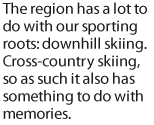
Interview


What are you working on right now?
Sven Fröhlich
Spring.
Martin Fröhlich
Extending my family
Can you guys be of any help?
(they both laugh)
OK – what are AFF working on as architects?
Sven Fröhlich
Just around the corner from here we’ve got what has to be the nearest building site
you can have as a studio. 200 meters away. A school. As far as Freudenstein Castle is
concerned, we’ve started on all the converting and refurbishing work. And for three
years now we’ve been involved with conversions, schools, school extensions.
You are actually in charge of the construction work as well? Not just in overall charge of the artistic side of things?
Martin Fröhlich
Indeed, it’s all part of building and architecture. We are closely involved with craftsmanship,
not just because a few of us learned trades first.
Which ones?
Martin Fröhlich
We’ve got bricklayers, model builders, and skilled builders, what a lovely way of
putting it, on board. With regard to the school: It’s an extension, not energy-related
refurbishing work. Then we’re also working on a terraced houses project. It’s a real
group project. With 11 developers.
Are you going to be moving in yourselves?
Martin Fröhlich
Indeed. Actually, the whole office was planning to move in, but ultimately there were
only three people left. And otherwise ... we are tinkering on designs for competitions.
Was the Sprengel Museum in Hanover your biggest success in recent competitions?
Sven Fröhlich
The biggest was Freiberg, which was then actually built. With the Sprengel Museum
we were in fourth place.

In the Deutsches Architekturzentrum (German architecture center), or DAZ, there was a recent exhibition in which you were presented as collectors. Where do you keep all the things on display there otherwise?
Martin Fröhlich
Here in the studio.
Excuse me?
Sven Fröhlich
Well, it was a bit more congested here. I don’t know what it’s like where you live...
Where we live, though, it’s a bit like here in the studio. And that’s with us already
having dismantled and sold our dark room! (to the photographer Torsten Seidel:) You
could have had yourself a Linhof!
You had a plate camera for professional use?
Martin Fröhlich
Sven studied photography. I’m more of a Nikon F3 type myself.
So you didn’t take all the photos in your exhibition on a cell phone?
Sven Fröhlich
Well yes, but... And there are sets of analog photos as well, we haven’t been through
them yet. We were once – there’s even an edition of ‘Bauwelt’ about it – at the Pioneers’
holiday camp in the Crimea, there are still 5,000 slides of it (it’s the ‘Bauwelt’
16, 2000 edition).
Why did you go to it?
Martin Fröhlich
It was the biggest Pioneers’ holiday camp! (laughter). Naturally enough, under the
aspect of there being Modernism in the East too! Back in former East Germany,
though, we all looked to the West. There was a seminar we did as assistants at college.
But also a spirit of adventure.
To get back to your passion for collecting: You both accumulate vast quantities of things?
Sven Fröhlich
Not just – the material is from the whole studio. It was important for us to sharpen
the team here.
Martin Fröhlich
It’s like with you as a writer, describing things, quoting. So you’ve read an awful lot and could carry on a conversation using quotations...
...you really think so!
Martin Fröhlich
That’s the image we have! (to Torsten Seidel) You as a photographer can remember
images, as a writer you can remember texts.

And as an architect...
Martin Fröhlich
... you’re somewhere in between: between being able to remember texts, images,
and objects.
And do you sometimes integrate the objects in the collection as ready-mades, precisely as they are, as it were, in your architecture?
Sven Fröhlich
We would certainly have a certain amount in store. But we deliberately didn’t put
such concrete things in the exhibition. And we even had a ban building parts. I could
open the cupboard right now and get out a box of some cable clips or other...
But you don’t put the things collected here to so concrete use?
Sven Fröhlich
You would find out if you were to take a look at Freiberg, or right now the school.
There are little details. A door stopper, for example, that comes from a totally different
field, from vehicle construction.

You like taking photographs of snow-covered cars, right?
Martin Fröhlich
The question sounds like the revelation of a fetish, that’s not what it is. We photograph
anything and everything that fascinates us. The best thing about the snowcovered
cars was that you’ve got this German value, this luxury vehicle, that people
spend their entire lives saving for. People spend more money on cars than on architecture.
These are the sort of similes we like using when we’re talking to developers.
About cars?
Martin Fröhlich
Not just cars. We grew up more at a time when we had television and other media.
That means that when you’re building a school you can talk about Teletubbies as
well...
Teletubbies?
Sven Fröhlich
As far as I’m concerned Teletubbies as well, yes. With us a lot gets done by way of
examples. Derived from metaphors. In principle developers like this sort of thing too.
“Just take a look at your car, you got everything right there as well “. That way it’s simply
easier to make yourself understood to the developers than by just talking about
architecture all the time.































































